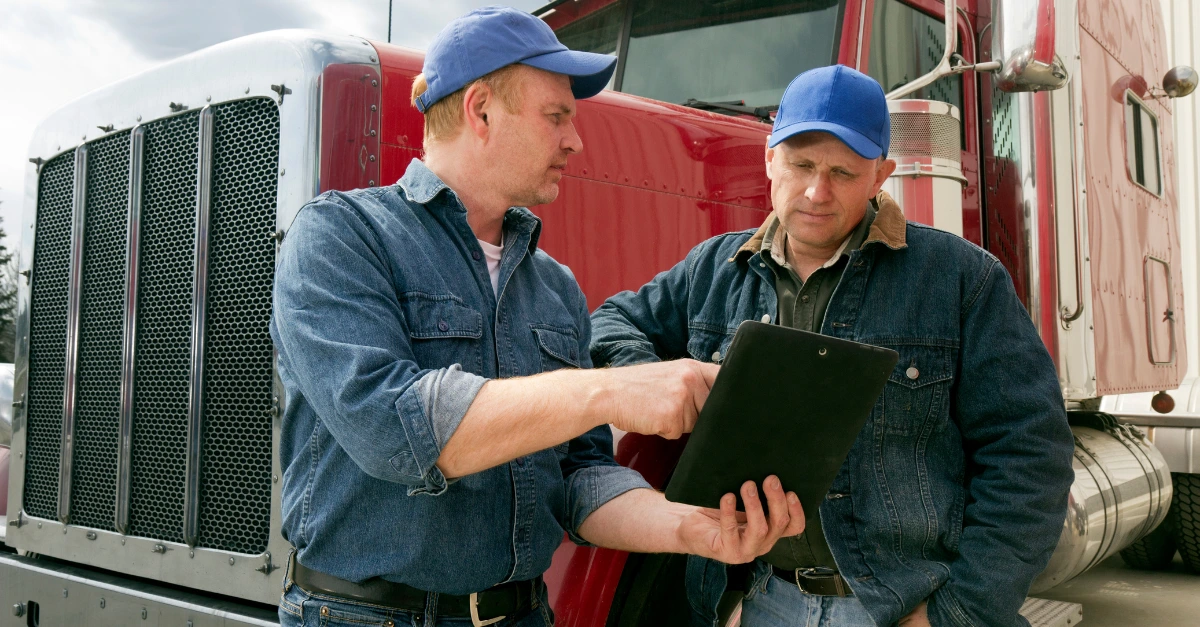The trucking industry is undergoing a tech-driven transformation, with artificial intelligence (AI) and telematics at the center of a new push for safety.
Telematics – the combination of telecommunications and informatics – allows trucks to stream data about driving and vehicle performance in real time. And AI systems are getting really good at making sense of all that data.
Why does this matter? Because when nearly 87% of truck crashes are attributed to human error, any tool that can help the driver avoid mistakes or mechanical problems is a potential lifesaver. From smart cameras that know if you’re dozing off to algorithms that predict when your brakes need fixing, “data-driven safety” isn’t just a buzzword – it’s changing how truckers stay safe on the road.
But with all this high-tech safety gear comes some high-profile worries. Browse any trucking forum and you’ll find plenty of chatter about “Big Brother” gadgets in the cab. Many drivers are concerned about privacy, feeling like a camera watching them in their own truck is a line crossed.
There’s also a question of trust – who is seeing this data and how will it be used? In this post, we’ll break down how AI and telematics are being used for driver monitoring, fatigue detection, behavior analytics, and predictive maintenance. We’ll also dive into the concerns independent owner-operators (rightfully) have around privacy and surveillance, and how the industry is addressing those worries.
Let’s hit the road and explore the data-driven future of trucking, in plain English.
AI-Powered Driver Monitoring: Watching Out for You
One of the most visible changes in truck cabs lately is the AI-powered driver-facing camera. These smart cameras act like a vigilant co-pilot, keeping an eye on the person behind the wheel. Using computer vision technology, an in-cab camera can literally watch the driver’s alertness – tracking things like where your eyes are looking, your head position, and even whether you’re wearing your seatbelt. The goal is simple: catch risky behavior in the moment so it can be corrected before it leads to an accident.
Some systems will sound an alert in real time, snapping you back to attention. Others might record a short video clip of the event and flag it for later coaching. In fact, many dashcam-based monitors don’t record everything continuously; they’re typically set to save footage only when triggered by specific events like hard braking, sudden swerving, or phone use. This event-based approach means the camera is there when it matters – say, if you slam on the brakes, it captures the 10 seconds before and after – rather than filming your every yawn. For an owner-operator, that can actually be a helpful shield: if a four-wheeler cuts you off and you brake hard to avoid a crash, the system records proof of what happened. It’s not about spying – it’s about having an automated witness and coach along for the ride.
The benefits of AI driver monitoring are clear from a safety standpoint. By catching distractions or risky habits early, these systems help drivers correct course and prevent accidents before they happen. Fleets that have adopted AI dashcams have reported significant reductions in accidents.
For independent truckers, a device like this can feel like a double-edged sword: nobody likes the idea of being watched, but it can provide an extra layer of protection. At the end of the day, a camera that knows if you’re paying attention is really watching your back. It’s there to remind you to keep your eyes on the road when fatigue or distractions creep in. And if something does go wrong, it could provide valuable evidence that you did your job right.
Fighting Fatigue with Smart Tech
Driver fatigue is a perennial foe of highway safety. We’ve all been there – that heavy-lidded feeling after too many miles, when the lines on the road start to blur. Traditionally, hours-of-service regulations (enforced by ELDs) are the main tool to combat drowsy driving. But let’s face it: a logbook can’t tell if you didn’t sleep well last night, or if you’re hitting a wall in the afternoon.
This is where AI-based fatigue detection comes into play, taking safety a step beyond just compliance. These systems use a mix of sensors and algorithms to actually measure your alertness in real time.
How does it work? Think of an AI fatigue monitor as a high-tech version of those sobriety tests cops give – but for tiredness instead of intoxication. A camera (usually mounted on the dash or windshield) watches your face and eyes for telltale signs: slow blink rates, drooping eyelids, yawning, head bobbing. Some systems even track steering patterns – tiny swerves or corrections that might indicate you’re not as sharp as usual. All this data gets crunched instantaneously by AI.
If the system thinks you’re dozing off or losing focus, it will trigger an alert – anything from a loud beep, a vibrating seat, to a voice prompt telling you to take a break. The primary goal is to wake up the driver (literally and figuratively) before a lapse ends in an accident.
For owner-operators, this is like having a personal safety coach on duty 24/7. It’s especially useful if you often drive overnight or irregular hours where your body’s clock might be out of sync. And importantly, fatigue monitoring isn’t about “catching” a driver in trouble; it’s about preventing trouble in the first place. It goes beyond the letter of HOS law to address the real spirit of it: making sure drivers are alert and safe.

Behavior Analytics: Learning from Driving Data
“Drive safe” isn’t just good advice – it’s becoming a quantifiable metric thanks to AI-driven driver behavior analytics. In the past, once you left the yard, your driving style was pretty much between you, your truck, and the highway. Now, telematics devices and AI analysis can build a detailed picture of how you drive, and use that to improve safety (and sometimes efficiency and fuel savings too).
So what kind of behavior are we talking about? Speeding, for one. If you tend to push 75 in a 65 zone, an AI system will catch that – not just as a one-off, but as a pattern if it happens often. Hard braking and rapid acceleration are other key metrics; they might indicate tailgating or aggressive driving if they happen frequently. Sharp cornering or lane deviations could flag that you’re taking curves too fast or not staying in your lane. Modern telematics units capture all these data points through sensors (accelerometers, gyroscopes, GPS, etc.), and AI software analyzes them to spot trends.
The real power of behavior analytics is turning data into coaching and improvement. AI can crunch years of incident reports and find out that certain habits (like habitual speeding or hard stops) correlate with higher accident risk. By identifying those habits before an accident happens, the system gives drivers a chance to adjust.
Don’t be surprised if your insurance company is interested in that data, too – safe driving analytics could potentially lead to lower premiums or bonuses for clean driving records in the future. Also, if a driver is consistently in the top safety percentile, that’s bragging rights and maybe a marketing point for your business (customers do care about safety records).
The key takeaway is that AI and telematics are shining a light on driving behavior in a way that helps build a culture of safety. We all have room to learn, and now we have more data to learn from, which will mean safer roads overall.
Predictive Maintenance: Fix It Before It Breaks
All the focus on driver behavior doesn’t mean the truck itself is ignored in this AI revolution. On the contrary, predictive maintenance might be a data-driven safety hero that doesn’t get enough hype. For an owner-operator, your truck is your business – a breakdown on the road isn’t just a safety hazard, it’s lost income, expensive repairs, and a whole lot of stress.
Traditional maintenance is all about scheduled service (like regular oil changes, tire rotations, etc.) and reacting to obvious issues (that weird engine noise or dash warning light that pops up). Predictive maintenance takes it to the next level by using AI to foresee problems before they smack you in the face.
Here’s how it works: Modern trucks often have a slew of sensors and diagnostic systems built in – measuring engine temperature, oil pressure, brake pad wear, tire pressure, battery voltage, you name it. These generate a constant stream of data while you drive. A predictive maintenance platform collects and analyzes that data in real time. It looks for patterns or anomalies that hint at a developing issue. Is the coolant temperature trending higher than usual under similar loads? Is one wheel showing frequent low tire pressure alerts (maybe a slow leak)? Is the engine taking a tad longer to crank recently (possible starter or battery issue)? AI excels at spotting these subtle changes that a human might miss.
Why’s that a big deal for safety? Because mechanical failures are a known cause of accidents – think of a blown tire or brake failure at highway speeds – and eliminating those surprises makes the road safer for you and everyone else. Plus, if you address an issue early, you avoid the breakdown on the side of the road (which is dangerous in itself) and the costly tow that follows. From an economic standpoint, predictive maintenance is a game-changer for owner-operators. It helps reduce unplanned downtime – keeping your truck running and making money – and can extend the life of your equipment by ensuring it’s properly cared for.
Some newer trucks might come with predictive analytics as part of the package; for older rigs, aftermarket telematics devices can often be installed to gain similar insights. The bottom line is: fixing something before it breaks is always easier (and cheaper) than fixing it after it breaks, and now AI is making that a practical reality.
The Big Brother Question: Privacy, Surveillance & Trust
For all the clear benefits of AI and telematics, there’s an elephant in the room we need to talk about: driver privacy and trust.
Independent drivers, especially those who’ve been around a while, are understandably wary of anything that feels like surveillance. Your truck isn’t just a vehicle – it’s your office, sometimes your home on wheels. The idea of a camera watching you in that personal space can feel intrusive, to put it mildly. On forums and in driver lounges, you’ll often hear these systems referred to as “Big Brother” – a reference to being under constant watch. Privacy remains one of the biggest concern drivers voice about in-cab monitoring tech, and it’s not just the feeling of being watched, but also worry about how the data might be used. Will your company or your insurer, or some other third party use a momentary distraction against you? Who gets to see the footage or the metrics, and for how long are they stored? These are all valid questions that the industry has had to grapple with.
The good news is that many companies are learning that safety tech won’t work if drivers don’t trust it. There’s a growing effort to strike a balance – to get the safety benefits without creating a spy-cam atmosphere. Here are some ways that’s being tackled:
- Event-triggered recording: As mentioned earlier, one common privacy safeguard is that driver-facing cameras are set to record/upload only during certain events (like a crash, hard brake, or other extreme events) instead of continuously livestreaming your every move. This helps drivers feel less like they’re constantly under a microscope. Some systems even have driver-facing LEDs that blink on when the camera is active, so you know if it’s recording or not.
- Clear data policies and transparency: Companies using these systems are learning to be up front about what exactly is being collected and why. Are they recording audio, or just video? Is the purpose purely safety coaching and accident evidence, or will the data be used in driver evaluations and firing decisions? By articulating the purpose and limits of data collection, and even involving drivers in drafting these policies, fleets can reduce the fear of misuse.
- Data security and control: Another concern is who can access the data. There’s not much worse than feeling like you’re being watched, except maybe thinking that those video clips could fall into the wrong hands. Strict access controls should be put in place – usually, only safety managers or specified personnel can review the footage, and only for defined reasons. Many vendors also auto-delete footage after a set time if it’s not tagged for a safety event, to further protect driver privacy.
- Building a culture of trust: Technology alone can’t fix trust issues. It takes good communication and driver involvement. The industry needs to continue to communicate out loud about the challenges drivers are voicing. They can also emphasize the positive aspects: these tools are there to protect drivers, not punish them. Regular meetings, Q&A sessions, and training on how the tech works (with real-life examples) go a long way. When drivers understand that AI isn’t there to play “gotcha” but to help everyone get home safe, acceptance grows. It’s also important that if a driver does get a nudge from the AI (say an alert for fatigue), it’s handled supportively – “take a break,” not “you’re in trouble.” Over time, as trust builds, more drivers come to see the AI as a partner rather than a spy.

The Road Ahead: Steering into the Future
As we look to the road ahead, one thing is certain – data-driven safety tech is here to stay, and it’s only going to get more advanced. We’re already seeing trucks equipped with collision avoidance systems that automatically brake or correct steering if an imminent crash is detected. In the not-so-distant future, trucks might be communicating with each other and the infrastructure around them (think convoys that “talk” to coordinate speed and spacing, or smart highways that relay real-time conditions).
AI will likely play a huge role in these developments – from semi-autonomous driving features to more sophisticated predictive analytics that can optimize everything from fuel efficiency to route planning in real time.
For independent owner-operators, the key is to stay informed and take a balanced approach. You don’t have to adopt every new gadget that comes along – and certainly not all at once. But being aware of what’s out there helps you make savvy decisions for your business. Maybe you decide a forward-facing dashcam is a must for protecting yourself from liability, but you hold off on a driver-facing camera until you feel more comfortable with the idea. Maybe you invest in a telematics device that offers engine diagnostics and predictive maintenance alerts, because you know a blown turbo can bankrupt you quicker than any speeding ticket. Each trucker’s situation is different, and one of the perks of being independent is that you call the shots on what tech rides along in your cab.
What’s exciting is that the technology is becoming more user-friendly and cost-effective. Not long ago, a lot of this AI stuff sounded like sci-fi (or was only used by mega-fleets). Now, a solo owner-operator can access many of the same safety benefits – sometimes right from a smartphone app or an affordable aftermarket device. If used right, these systems truly do make the job safer and easier. They’re not about replacing the driver – they’re about empowering the driver with better information and a safety net.





